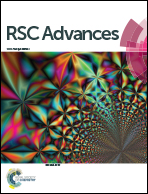Theoretical insights into structure, bonding, reactivity and importance of ion-pair interactions in Kirby's tetrafluoroboric acid salts of twisted amides†
Abstract
The geometries of the amides 1-azatricyclo [3.3.1.13,7] decan-2-one, tetrafluoroboric acid salt (1), 3-methyl-1-azatricyclo [3.3.1.13,7] decan-2-one, tetrafluoroboric acid salt (2), and 3,5,7-trimethyl-1-azatricyclo [3.3.1.13,7] decan-2-one, tetrafluoroboric acid salt (3) have been calculated at the DFT-D3 (BJ) level using density functionals PBE, PBE0, TPSS and TPSSH. The optimized structure of (1) at the DFT/PBE0-D3(BJ) level of theory in methanol is in excellent agreement with the experimental structure. The geometries of the hydrolyzed products (4–7) have been optimized with PBE and PBE0 functionals. In the studied compounds (1–3), the [BF4]− anion interacts with cationic fragments [1]+, [2]+ and [3]+ through the N–H⋯F hydrogen bond. The ion-pair interactions affect the C–N–H bond angles which are relatively smaller (110.3° in 1, 109.9° in 2, 110.0° in 3) than those for cationic fragments (104.8° in 1+, 104.8° in 2+, 105.1° in 3+). The charge analysis formulates the salts (1–3) as [cation]q+[BF4]q− with q = ∼0.81. The high stability of ion-pairs is due to significant flow of charge from the BF4− anion to the cation. There is significant hydrogen bonding (H⋯F) interaction in 1–3. Salt 1 has the lowest ion pair dissociation energy of ΔE = 5.46 kcal mol−1 in methanol and 4.91 kcal mol−1 in acetonitrile. The hydrolysis reaction of 1 is most exothermic (ΔE = −11.84 kcal mol−1) and thus it is more favourable. The hydrolysis of amides 2 and 3 with a bridgehead methyl is relatively less favourable. Hydrolysis reactions of amides 1 and 3 at the DFT/PBE-D3(BJ) level in acetonitrile have been investigated. The calculated enthalpies of the hydrolysis product formation are 4, 41.61 kcal mol−1 and 7, 32.43 kcal mol−1.


 Please wait while we load your content...
Please wait while we load your content...